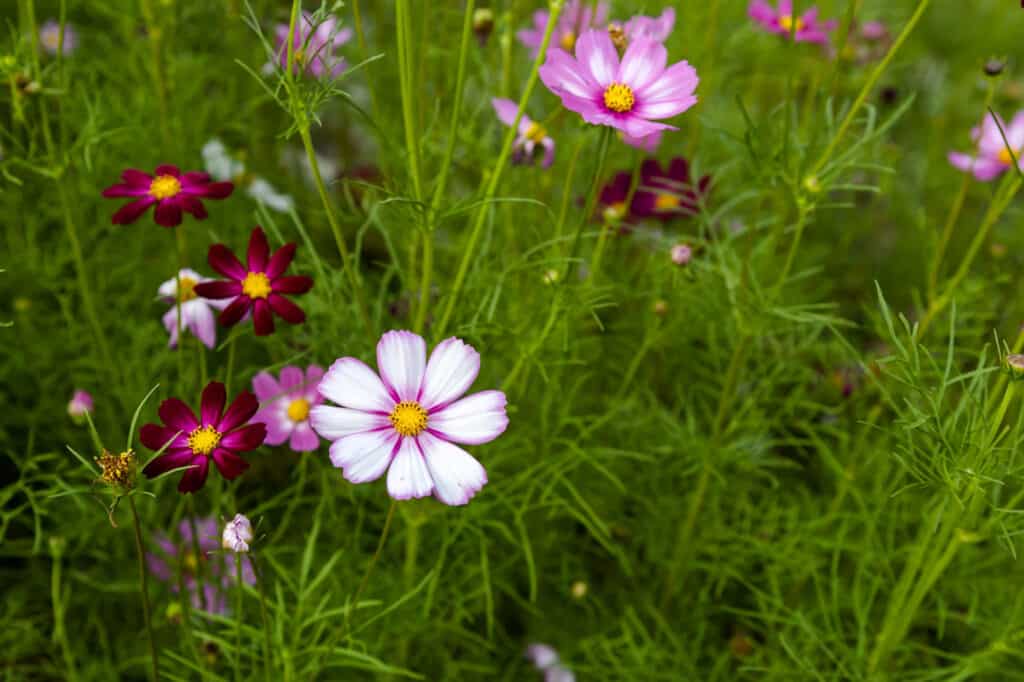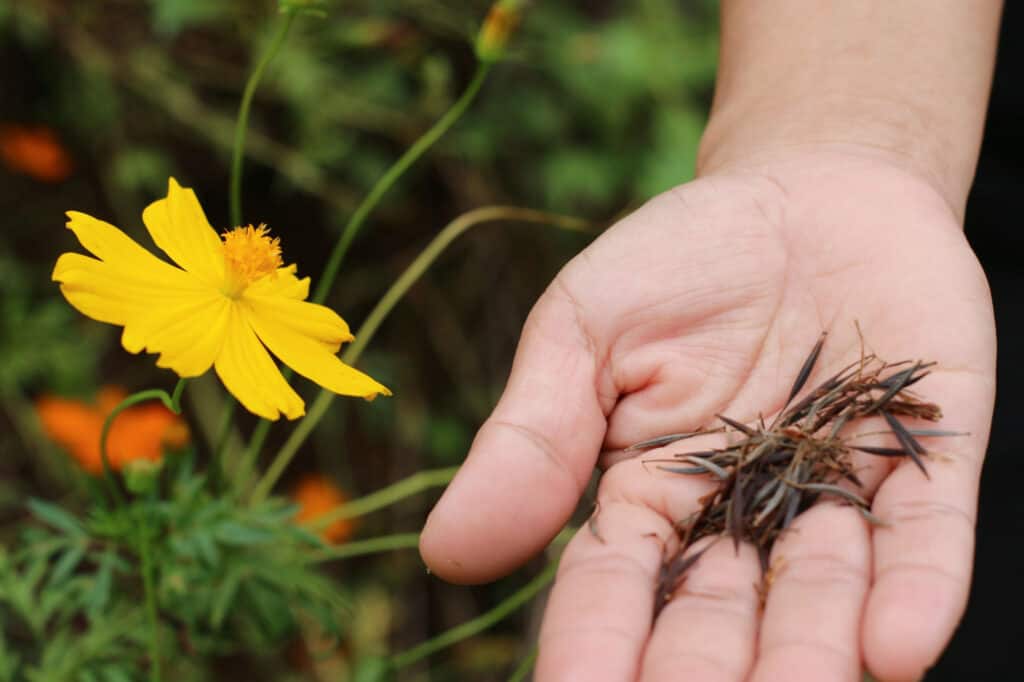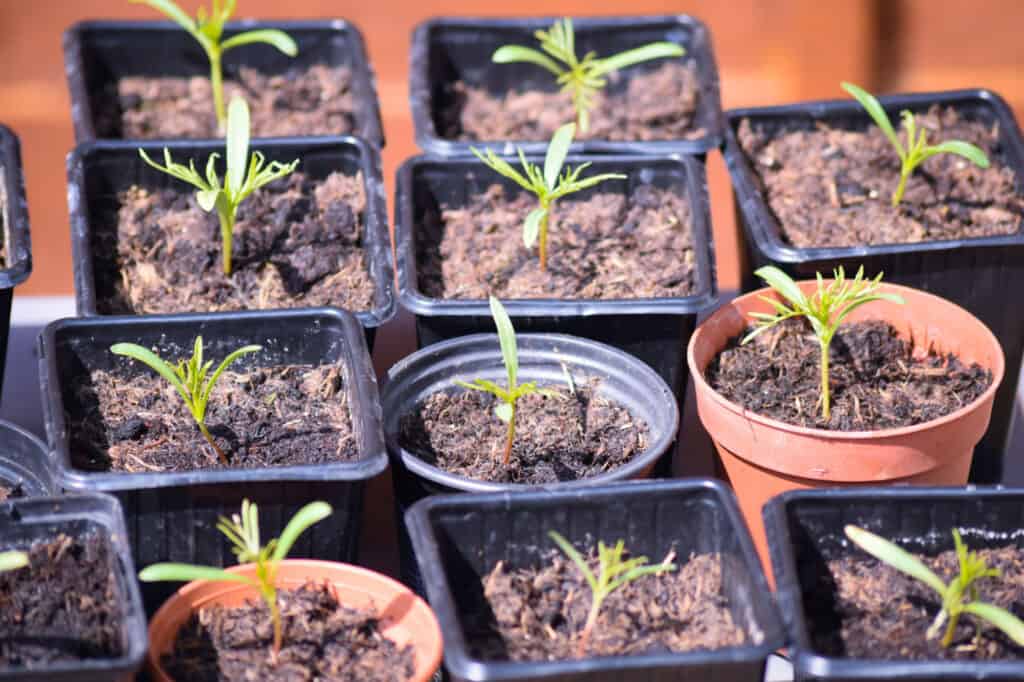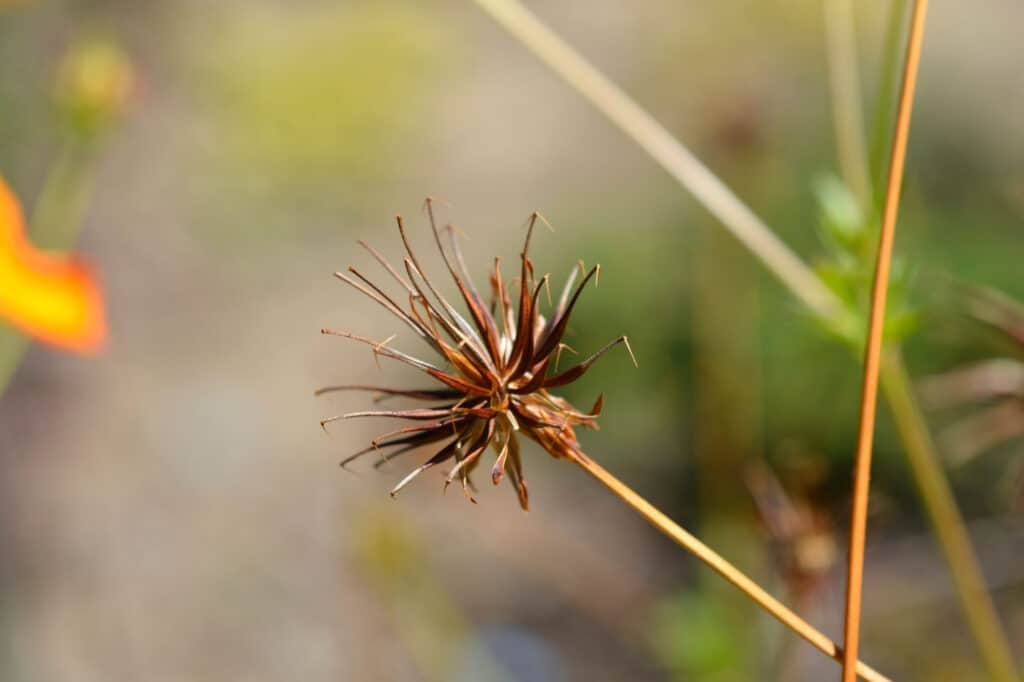Cheery and bright, there are countless varieties of cosmos seeds. This annual is ideally grown in a number of climates and regions of the world, and you just can’t beat the number of color combinations that cosmos come in! But can you grow cosmos flowers from seed in your own backyard, and how might you best accomplish this process?
Growing cosmos seeds is as easy as spreading them no more than a 1/4th inch deep in your garden soil once any fear of spring frost dates have past. Simply thin the seedlings as they sprout, and be patient, as it can take almost two months for flowers to bloom. You can also start cosmos seeds indoors to get a jumpstart on their iconic colors!
If you want to enjoy the simple and elegant beauty of the cosmos flower in your own backyard garden or landscaping, here’s how to grow cosmos seeds from start to finish!

You can start cosmos seeds indoors to get a jumpstart on their iconic colors!
©lotlenglu/Shutterstock.com
| Cosmos Seeds | How to Grow |
|---|---|
| Hardiness Zones | 2 through 11; annual flower |
| Number of Cosmos Varieties | Hundreds of colors and types across 25 different species |
| Time of Year to Germinate Seeds | Direct sow in springtime, or start indoors 2-3 weeks before final frost date |
| Time of Year to Plant Seedlings | Direct sow after any dangers of spring frost, or plant seedlings at same time |
| Things to Note | Some cosmos varieties grow tall, so be sure to keep some stakes or other support methods handy! |
Types and Varieties of Cosmos Seeds

While you can always harvest your cosmos seeds at the end of a long and hot summer, keep in mind that these blooms will make their own way if left to their own devices.
©iStock.com/Waraphot Wapakphet
Since cosmos flowers are so easily grown from seed, you should spend some time choosing a variety that appeals to you. Members of the Aster or Daisy family, cosmos come in many colors and shapes, depending on their specific species or cultivar.
Some of the most popular cosmos cultivars include:
- Candystripe. Delicate white petals with pink or red edges. Can reach up to 6 ft tall.
- Cupcakes and Saucers. Unique variety with inner petals surrounded by large outer petals!
- Sea Shells. In a variety of colors, these cosmos have trumpet-shaped petals.
- Chocolate. A separate cosmos species, these petals do indeed smell like chocolate!
- Ladybird. Shorter cosmos, found in reds, oranges, and yellows.
- Sensation. A seed blend full of red, pink, and white cosmos, perfect for any garden.
- Bright Lights. Similar in appearance to marigolds, these cosmos come in striking colors.
What Do Cosmos Seeds Look Like?

Members of the Aster or Daisy family, cosmos come in many colors and shapes, depending on their specific species or cultivar.
©Pirunpon/Shutterstock.com
When it comes to identifying cosmos seeds, you’ll likely learn to recognize them in no time. Given that cosmos flowers go to seed at the end of each growing season, their seeds are elongated and thin, up to an inch long, often looking like splinters or small slivers of wood. Cosmos seeds are primarily dark or black in color, and they often have ends that are thinner and more pointed than their centers.
Given the fact that these seeds are thin and light, you can no doubt guess just how easy it is for these flowers to spread these seeds all on their own. While you can always harvest your cosmos seeds at the end of a long and hot summer, keep in mind that these blooms will make their own way if left to their own devices, often spreading seeds further away than most homeowners plan for!
Germinating and Growing Cosmos Flowers from Seed

While your cosmos will bloom and re-bloom all summer long, you’ll know that your cosmos have run their course when their flower heads turn brown.
©Timedwing/Shutterstock.com
Growing cosmos flowers from seed is extremely easy. You can either choose to begin your seeds inside a few weeks before your final spring frost date, protected from the cold. Or, often the preferred method, you can directly sow your cosmos seeds outside when your frost date has passed.
Here’s how to germinate and grow cosmos flowers from seed!
- Scatter your seeds across a basic planting soil. Cosmos don’t actually do well in a soil that is rich in any particular nutrients, as the plant will put more time into its stems than its blooms. Many different cosmos varieties thrive where other flowers will not, so don’t overthink these beauties!
- Loosely cover your seeds in no more than a 1/4th inch of soil. You’ll likely need to thin your cosmos seedlings as they grow, and sunlight is key for these flowers to germinate. Don’t worry about burying your cosmos seeds too deep, and don’t worry about spacing them out just so.
- Let your seeds germinate and grow. Most cosmos varieties need at least 20 days to develop roots, and your blooms likely won’t appear until day 50-70. However, with proper care, your cosmos will continue blooming all summer long!
- If you chose to grow your cosmos indoors, plant outside after 3-4 weeks. Space your cosmos seedlings accordingly, roughly a foot apart, and make sure to only plant after your frost danger has passed!
Harvesting Cosmos Seeds

Unless you don’t mind a few wayward cosmos seeds falling into your garden, you may need to take some extra care gathering your cosmos flower heads.
©Nahhana/Shutterstock.com
Cosmos seeds are incredibly easy to harvest. While your cosmos will bloom and re-bloom all summer long, you’ll know that your cosmos have run their course when their flower heads turn brown. One of the most obvious tells for when your cosmos seeds are ready for harvesting? The plant will be dried to the touch, and have a distinct brown hue.
Unless you don’t mind a few wayward cosmos seeds falling into your garden, you may need to take some extra care gathering your cosmos flower heads. Make sure to hold a jar or an open bag directly beneath any flower heads that you want to collect. Gently pluck the entire flower head off of the plant, once it has turned brown and dried out.
You can easily sort your seeds from your chaff, as they will be a darker brown hue. Store your seeds for up to five years in an envelope or jar, and enjoy your beautiful cosmos flowers for seasons to come!
Up Next
- 15 Best Potted Annual Flowers to Attract Pollinators
- 9 Flowers to Plant in October
- Lupine Seeds: Grow This Beautiful Wildflower in Your Own Garden
The photo featured at the top of this post is © iStock.com/Waraphot Wapakphet
Sources
- Genetic experiments with Cosmos. II, Available here: https://www.jstage.jst.go.jp/article/pjab1912/10/1/10_1_33/_article/-char/ja/
- Qualitative and Quantitative Analysis of Flower Pigments in Chocolate Cosmos, Cosmos Atrosanguineus, and its Hybrids, Available here: https://journals.sagepub.com/doi/abs/10.1177/1934578X1601100122
Thank you for reading! Have some feedback for us? Contact the AZ Animals editorial team.






